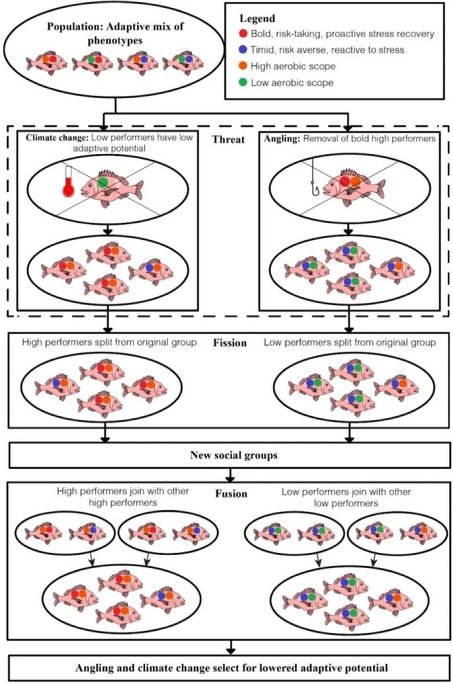Normally when i like a paper a do a deep dive, take some notes and write here about it. Yet the last month has been quite busy as i’m doing a lot of reading of papers for meetings, finishes an estimation of containerisation for FFA, review a IUU NPOA that was done under format i designed, did some work on transhipment observers, work on a carrier inspection training manual, and my ocean acidification course, and my training for swimming 20 km next week for charity, made for a rather exhausting schedule so my blogging rate has been low.
I had a go to the following papers that I enjoy even if was only a “light” read. As a non specialist (and a non academic) I have the luxury to have various interests in what are very different areas of fisheries… yet after almost 40 years in I fisheries, I see it has a very dynamic model where everything has an influence at some stage… either direct of indirectly.
This is something big for us here in the pacific, so i like to keep up to the game. I know two of the authors (Colette C. C. Wabnitz, and Rashid Sumaila) but also one of the reviewers: numbers maverick and fellow dubber Alex Tidd. The abstract is self explanatory:
Climate change is shifting the distribution of shared fish stocks between neighboring countries’ Exclusive Economic Zones (EEZs) and the high seas. The timescale of these transboundary shifts determines how climate change will affect international fisheries governance. Here, we explore this timescale by coupling a large ensemble simulation of an Earth system model under a high emission climate change scenario to a dynamic population model. We show that by 2030, 23% of transboundary stocks will have shifted and 78% of the world's EEZs will have experienced at least one shifting stock. By the end of this century, projections show a total of 45% of stocks shifting globally and 81% of EEZs waters with at least one shifting stock. The magnitude of such shifts is reflected in changes in catch proportion between EEZs sharing a transboundary stock. By 2030, global EEZs are projected to experience an average change of 59% in catch proportion of transboundary stocks. Many countries that are highly dependent on fisheries for livelihood and food security emerge as hotspots for transboundary shifts. These hotspots are characterized by early shifts in the distribution of an important number of transboundary stocks. Existing international fisheries agreements need to be assessed for their capacity to address the social–ecological implications of climate-change-driven transboundary shifts. Some of these agreements will need to be adjusted to limit potential conflict between the parties of interest. Meanwhile, new agreements will need to be anticipatory and consider these concerns and their associated uncertainties to be resilient to global change.
China’s seafood imports—Not for domestic consumption?
Already 20 years ago we were catching Hoki, doing gill and gutting, freezing on board, unloading to containers and sending to China for processing and exporting. A few years later the company actually establish a joint venture there with a local processor and sold under its own brand… New Zealand caught fish to US and EU consumers… you had to look on the fine point to see was processed in China.. all above board in terms of labelling and compliance (to make happen was my job at the time).
So obviously i was interested to see what what the present situation… and i have to admit it blew me away…. China is the biggest fishing nation in the works on all metrics… yet this paper estimates that we estimate that almost 75% % of imports to China are processed and reexported.
Here is the abstract: Global trade in seafood is tightly coupled with environmental, economic, and social sustainability. Yet, two features of global seafood trade hamper efforts to promote sustainability. First, the recent practice of importing seafood, processing it, and then exporting it (“reexporting”) at a large scale complicates tracing seafood from the water to the plate and enables mislabeling. Second, reexports can exacerbate problems stemming from distant-water fishing (DWF), i.e., fish caught in international waters and other countries’ economic zones. DWF obscures the distinction between domestic and imported seafood and is implicated in illegal, unreported, and unregulated (IUU) fishing and other unsustainable practices (5). Both features highlight the critical role of China, the world’s largest DWF nation and largest seafood producer, consumer, exporter, and importer (by volume). Contradicting the narrative that Chinese domestic demand is driving imports, we estimate that 74.9% of imports to China are processed and reexported.
Links between behaviour and metabolic physiology in fishes in the Anthropocene
This is interesting one as it tackles the issue of recreational fishing to and extent. As non motorised spear-fisherman, I see the massive impact that recreational fisheries have in developed countries particular close to urban areas, as in my home, Waiheke Island in the Hauraki Gulf of NZ.
The paper is wide but im very interested in the following concept: “While, it appears that all types of capture fisheries are likely to reduce the adaptive potential of fished populations to climate stressors, angling, which is primarily associated with recreational fishing, may induce the separation of natural populations by removing individuals with bold behavioural traits and potentially the physiological traits required to facilitate behavioural change.”
In the graph you see here, that suggest/concludes that recreational fishing and climate change select for lowered adaptive potential… and that is not good news… as we never had so much of both like now.
Here is the abstract:
Changes in behaviour and physiology are the primary responses of fishes to anthropogenic impacts such as climate change and over-fishing. Behavioural changes (such as a shift in distribution or changes in phenology) can ensure that a species remains in an environment suited for its optimal physiological performance. However, if fishes are unable to shift their distribution, they are reliant on physiological acclimatization (either by broadening their metabolic curves to tolerate a range of stressors, or by shifting their metabolic curves to maximize their performance at extreme stressors). However, since there are links between fish physiology and behaviour, changes to either of these trait groups may have reciprocal interactions.
This paper reviews the current knowledge of the links between the behaviour and aerobic metabolic physiology of fishes, discusses these in the context of exploitation and climate change and makes recommendations for future research needs. The review revealed that our understanding of the links between fish behaviour and metabolic physiology is rudimentary. However, both are hypothesized to be linked to stress responses along the hypothalamic pituitary axis. The link between metabolic physiological capacity and behaviour is particularly important as both determine the response of an individual to a changing climate and are under selection by fisheries. While, it appears that all types of capture fisheries are likely to reduce the adaptive potential of fished populations to climate stressors, angling, which is primarily associated with recreational fishing, may induce the separation of natural populations by removing individuals with bold behavioural traits and potentially the physiological traits required to facilitate behavioural change. Future research should focus on assessing how the links between metabolic physiological capacity and behaviour influence catchability, the response to climate change drivers and post-release recovery. The plasticity of phenotypic traits should be examined under a range of stressors of differing intensity, in several species and life history stages. Future studies should also assess plasticity (fission or fusion) in the phenotypic structuring of social hierarchy and how this influences habitat selection. Ultimately, to fully understand how physiology is influenced by the selective processes driven by fisheries, long-term monitoring of the physiological and behavioural structure of fished populations, their fitness and catch rates are required. This will provide information that can be used by managers to retain behavioural and physiological trait diversity, which will be necessary to improve the resilience of fished populations to the impacts of climate change and safeguard the provision of resources for future generations.

